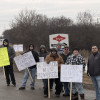Flickr photo by brunkfordbraun
ONE OF THE MOST hazardous substances we might encounter in the workplace, asbestos has been used for centuries because of its excellent fire resistance and insulating properties. Asbestos has been used widely in construction, shipbuilding, and boiler manufacture because of its availability, low production cost, and high tensile strength. Boilermakers are likely to encounter asbestos-containing materials (ACM) in a variety of settings — on the job and in their own homes.
Asbestos appears as a fiber. But what looks like a single fiber is actually thousands of fibers, each of which can be divided even further into microscopic fibers. When ACM is disturbed, these microscopic fibers can become airborne and enter a person’s lungs without being noticed.
In the lungs, asbestos may cause asbestosis, lung cancer, or mesothelioma — all of which can be fatal. Because the symptoms of these diseases may not appear for 15-40 years, workers sometimes convince themselves they can work around asbestos without taking precautions. Don’t be lulled into complacency by that macho fellow worker who says he has worked with asbestos for 20 years and never gotten ill. He may be in for a terrible surprise in a few more years.
Health hazards
HUNDREDS OF MEDICAL studies have shown that inhaling asbestos fibers may increase the risk of developing lung diseases.
Years ago, asbestos workers were often exposed to high concentrations of asbestos fibers with little or no protection. Today, asbestos workers follow specific work practices and wear protection to minimize the risk of exposure. Nonetheless, the following diseases continue to appear, suggesting that many workers are still not getting the proper protection for asbestos exposure.
ASBESTOSIS. Asbestos primarily damages the lungs. Once inhaled, asbestos-containing dust particles may reach tiny air sacs, where large cells called macrophages attempt to engulf the particles and “digest” them. When that is not successful, these cells deposit a coating on the fibers and begin forming scar tissue around them. When enough scar tissue is formed, asbestosis results.
Asbestosis reduces lung capacity, so the first symptom is usually shortness of breath. The greater the exposure, the more likely the disease is to develop, so asbestosis is most common among workers who have been exposed to high concentrations over a long period of time. All forms of asbestos can cause asbestosis, and the disease typically is not diagnosed until 15-30 years after exposure.
LUNG CANCER. Asbestos is one of many causes of lung cancer. Workers exposed to asbestos are five times as likely to develop lung cancer as workers never exposed. Cigarette smokers exposed to asbestos are 50 times as likely to develop asbestosis as nonsmokers who are not exposed.
The risk increases because cigarette smoke paralyzes the cilia — a hairlike lining of the airways. Cilia capture dust and debris before they can enter the lungs, protecting the lungs from toxic substances. Paralyzed by cigarette smoke, the cilia are unable to stop asbestos fibers from reaching and harming the lungs.
MESOTHELIOMA is the most serious asbestos-associated disease. Fortunately, it is also the rarest. Mesothelioma is a cancer that can form in the chest or abdominal cavity. It spreads rapidly and is always fatal. The exact mechanism of this disease remains unknown, and some mesothelioma victims have had only limited exposure to asbestos. Mesothelioma may not develop for 30-40 years after initial exposure.
Where asbestos may be found
BECAUSE ACM MAY be found in a variety of locations and materials, many of the daily tasks Boilermakers perform can result in asbestos exposure if proper work practices are not followed. Before disturbing any unknown material or material that could contain asbestos, consult with your supervisor so qualified personnel can identify and administer the proper protocol.
The most common use for asbestos has been fireproofing. In construction, it was sprayed on steel beams, columns, and decking to prevent these structural members from warping or collapsing in a fire. It was also mixed with such materials as vermiculite, sand, cellulose fibers, gypsum, and calcium carbonate to form fireproofing materials.
When used for thermal insulation and condensation control, asbestos was usually spray-applied, trowel-applied, or factory installed on or within equipment, vessels, pipes, boilers, and furnaces.
Additionally, asbestos was added to a variety of building materials to enhance strength. It is found in concrete and concrete- like products, siding and roofing shingles, wallboard, roofing, cladding, partitions, and pipes. Asbestos has also been added to asphalt, vinyl, and other materials to make such products as roofing felts, exterior siding, floor tile, joint compounds and adhesives, and gaskets. Many of these products are still in use today.
Because asbestos can appear in so many locations, workers must always be careful when undertaking any activity that can disturb a structural component. It isn’t necessary to cut into the material to release asbestos into the air. ACM can be disturbed by attaching rigging components (slings, chain-falls, come-alongs) to pipes, beams, or other components insulated or fireproofed with ACM. Flange-breaking and removing valves, piping, or vessels insulated with ACM can also release asbestos.
In many industrial environments, pipes, beams, vessels, etc., were insulated or “fireproofed” with ACM. To prevent the release of asbestos fibers, these materials must remain intact and not be disturbed. If you find it necessary to access these areas, consult your supervisor and have the material identified and removed by qualified asbestos workers prior to beginning your work.






